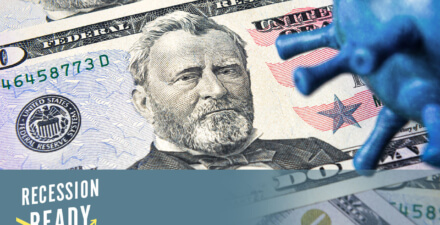Brad DeLong: Worthy reads on equitable growth, June 27-July 6, 2020
Worthy reads from Equitable Growth:
1. Cutting through the fog on the meaning of “financial inclusion,” which should not—but often does—mean “we will induce you to pay usurious interest rates for short-term loans,” should get you to this—one’s financial transactions mirror those of middle-class America: Read “In Conversation with Mehrsa Baradaran,” in which she says: When you hear financial inclusion a lot in the media, it’s based on some new fintech company or blockchain or some new app … [but one] used to think about it as microcredit or some sort of alternative system for the poor … That, I think, is a misunderstanding … There are people … excluded from the financial system. They don’t have access to credit or services … unbanked or underbanked … they don’t have a bank account … It just costs a ton of money if you don’t have a bank account to do any sort of transaction. Anything you buy online, anytime you go to a store, checks, all of that stuff is provided for those of us who have bank accounts pretty seamlessly through apps and the internet, debit cards, credit cards, all of that stuff. If you don’t have a bank account, then you just have to pay a ton of money, up to perhaps 10 percent of your income just to cash checks and get prepaid debit cards.”
2. I used to lecture that in the 20th century in the global north the stakes involved in being poor were not overwhelmingly high—the life expectancy and mortality differences across economic classes had greatly narrowed relative to what they had been in previous centuries. I can no longer make that argument. The differential class impacts of the novel coronavirus, in income and in mortality, are large in the United States. Read Kate Bahn and Carmen Sanchez Cummings, “Latest jobs report for June reveals pre-existing inequality worsening amid coronavirus recession, in which they write: “The brunt of the job losses due to the coronavirus recession continue to fall heaviest on Black and Latinx workers … [in] May 2020 and June 2020 … the U.S. economy gained 4.8 million nonfarm payroll jobs, the share of the employed prime-aged population increased from 71.4 percent to 73.5 percent, and the jobless rate fell from 13.3 percent to 11.1 percent … The share of unemployed workers who report having permanently lost their jobs increased for the second month in a row, jumping from 14 percent in May to 20.9 percent in June … Improvements in the labor market have been uneven, and that Black and Latinx workers, in addition to women workers and low-wage workers generally, continue to be disproportionately affected by the coronavirus recession.”
3. If you missed this, it would be really worth your time to go back and watch “Experts Discuss Transformative Ideas for 2020 economic policy debate at Vision 2020 event,” in which the panelists proposed to: “Eliminate banks as the ‘middleman’ for federal anti-recession aid. Cancel all student loan debt. Give workers a say in how their workplaces reopen and empower them to form unions. Provide federal relief to childcare programs to prevent them from shutting down permanently. Get Congress to do its job so the Federal Reserve can get out of the business of making fiscal policy. These ideas for generating strong, sustainable, and broad-based economic growth and achieving racial justice in the wake of the coronavirus recession were put on the virtual table during a June 25 webinar sponsored by the Washington Center for Equitable Growth. “Vision 2020: Focusing on economic recovery and structural change.”
Worthy reads not from Equitable Growth:
1. In many cases, a skilled worker with a good job is an unskilled worker with a union. Thus I do not understand Danny Rodricks focus on “technology” and “globalization” as drivers of the income distribution. Yes, they are drivers of the distribution of economic activity among sectors and of the distribution of employment across job categories. But they have little to do with the issues of distribution that are at the core of concern. Read Dani Rodrik, “Reshaping Economic Strategy After COVID-19,” in which he writes: “The crux of the matter: ‘good jobs’ are becoming scarce: ‘Good jobs’ [provide] stable employment that enables at least a middle-class existence, by a region’s standards, and comes with core labor protections such as safe working conditions, collective bargaining rights, and regulations against arbitrary dismissal. Underlying drivers: technology and globalization. But these are not exogenous processes outside our control! Employment and innovation decisions affecting labor demand produce significant externalities—’good jobs’ externalities.”
2. For reasons that have never been clear to me, central banks have hitherto always focused on influencing interest rates at the short end of the yield curve. I understand why you would do so in a financial crisis. In a financial crisis it is the stringency of short-term money that is the key problem. But when central banking moves out from dealing with dire and immediate crises into the business of making Say’s Law generally true in practice even though it is false in theory—the business of matching the propensity to save with the animal spirits of enterprisers—the short-run opportunity cost of immediate cash money is no longer a key or even an especially interesting financial economic quantity to manage. Yet central banks have consistently, historically, and traditionally focused on managing it. Now, finally, the Bank of Japan has been experimenting with alternatives. And they look very promising. Read Matthew Higgins and Thomas Klitgaard, “Japan’s Experience with Yield Curve Control,” in which they write: “Any central bank considering a move to implement its own version of Yield Curve Control … has many questions to ponder … For Japan … YCC has had one clear benefit. Under the new policy, the Bank of Japan has been able to exert fairly close control over the term structure of interest rates without resorting to large-scale interventions in the Japanese Government Bond market. Investors accept that the Bank can buy whatever quantity of JGBs is needed to keep yields from rising and, as a result, it has not had to buy many at all.”
3. One of Karl Polanyi’s insights from the third to the sixth decades of the 2000s was that people demand not that the distribution of income be equal but that it be fair and that it be secure. Those who find themselves lacking security, and who also believe that they are unfairly not receiving what is their due, make up what Guy Standing calls the “precariat.” They form a reservoir for counter-establishment political movements as they attempt to use politics as a channel for society’s reaction against the unfair and unstable workings of the economy. Here Nouriel Roubini sees a certain symmetry in two wings of this precariat. I am not at all sure he is right. But it is an interesting argument to consider. Read Nouriel Roubini, “The Main Street Manifesto,” in which he writes: “After the 2008 financial crisis, many firms sought to boost profits by cutting costs, starting with labor. Instead of hiring workers in formal employment contracts with good wages and benefits, companies adopted a model based on part-time, hourly, gig, freelance, and contract work, creating what the economist Guy Standing calls a “precariat.” Within this group, he explains, “internal divisions have led to the villainization of migrants and other vulnerable groups, and some are susceptible to the dangers of political extremism .. One segment of the precariat comprises younger, less-educated white religious conservatives in small towns and semi-rural areas who voted for Trump in 2016. They hoped that he would actually do something about the economic “carnage” that he described in his inaugural address … But the American precariat also comprises urban, college-educated secular progressives who in recent years have mobilized behind leftist politicians like Senators Bernie Sanders of Vermont and Elizabeth Warren of Massachusetts. It is this group that has taken to the streets to demand not just racial justice but also economic opportunity … As a satirical headline in The Onion recently put it: “Protesters Criticized for Looting Businesses Without Forming Private Equity Firm First.” It is no secret that what is good for Wall Street is bad for Main Street … The American Dream was always more aspiration than reality … But with social mobility now declining as inequality rises, today’s young people are right to be angry. The new proletariat—the precariat—is now revolting.”






